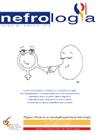继发性高草酸尿症:慢性肾病的原因和后果
IF 2
4区 医学
Q2 UROLOGY & NEPHROLOGY
引用次数: 0
摘要
继发性高草酸尿是一种代谢紊乱,其特征是尿中草酸盐排泄增加。病因可能是由于草酸盐或其前体的摄入增加,消化水平的消除减少,或肾脏排泄增加。最近,SLC26A6转运体在本病发病机制中的作用被发现。它存在于肠道和肾脏水平。它的作用机制在全身性炎症和代谢综合征的情况下发生改变,这可以解释近几十年来继发性高草酸尿病例的增加。治疗包括卫生的饮食措施,以及旨在通过增加粪便排泄来减少其在肠道吸收的药物。不同的免疫调节药物、微生物组调节剂和SGLT2抑制剂可能构成新的治疗靶点。目前对于继发性高草酸尿我们没有特异性的治疗方法,因此早期诊断和预防肾衰竭进展的措施是目前主要的治疗手段。本文章由计算机程序翻译,如有差异,请以英文原文为准。
Hiperoxaluria secundaria: causas y consecuencias de la enfermedad renal crónica
Secondary hyperoxaluria is a metabolic disorder characterized by an increase in urinary oxalate excretion. The etiology may be due to an increase in the intake of oxalate or its precursors, a decrease in elimination at the digestive level, or an increase in renal excretion. Recently, the role of the SLC26A6 transporter in the etiopathogenesis of this disease has been discovered. It is present at both the intestinal and renal levels. Its mechanism of action is altered in situations of systemic inflammation and metabolic syndrome, which could explain the growing increase in cases of secondary hyperoxaluria in recent decades. Treatment includes hygienic dietary measures, as well as drugs aimed at reducing its absorption at the intestinal level by increasing fecal excretion. Different immunomodulatory drugs, microbiome modifiers and SGLT2 inhibitors could constitute new therapeutic targets. At present, we do not have specific treatments for secondary hyperoxaluria, so early diagnosis and measures aimed at preventing the progression of kidney failure are currently the main therapeutic tools.
求助全文
通过发布文献求助,成功后即可免费获取论文全文。
去求助
来源期刊

Nefrologia
医学-泌尿学与肾脏学
CiteScore
3.40
自引率
7.70%
发文量
148
审稿时长
47 days
期刊介绍:
Nefrología is the official publication of the Spanish Society of Nephrology. The Journal publishes articles on basic or clinical research relating to nephrology, arterial hypertension, dialysis and kidney transplants. It is governed by the peer review system and all original papers are subject to internal assessment and external reviews. The journal accepts submissions of articles in English and in Spanish languages.
 求助内容:
求助内容: 应助结果提醒方式:
应助结果提醒方式:


